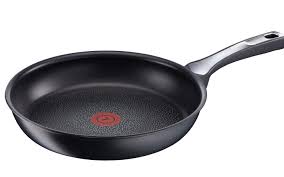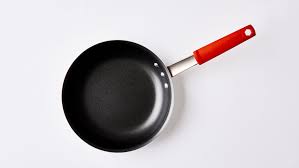Whether you’re searing meat, stir-frying vegetables, or quickly reducing a pan sauce, a good skillet is an indispensable workhorse in the kitchen. After more than 90 collective hours of research and testing since 2014, we still believe the tri-ply All-Clad D3 Stainless Fry Pan with Lid 12 Inch is the best skillet for your money. It’s a durable pan that heats extremely evenly. No other pan gets the kind of raves the All-Clad receives from professionals, enthusiasts, and home cooks alike. Yes, it’s expensive, but it will last you a lifetime, making it a great value.
The All-Clad D3 Stainless Fry Pan with Lid 12 Inch’s substantial tri-ply construction distributes heat evenly, allowing you to sear foods with less risk of burning. The pan’s sturdy stick handle and lightweight design make it easy to maneuver when you’re sautéing or transferring it from the stovetop to the oven. Out of all the skillets we tested, the All-Clad’s stainless steel exterior was among the most resistant to discoloration from heat, even after years of regular use. The generously sloped sides and bent lip allow you to easily whisk and pour pan sauces. The All-Clad was also one of the few skillets we tested that included a lid.

To learn more about what makes a great skillet, we spoke to experts such as Charlyne Mattox, food and crafts director at Country Living and the author of Cooking with Seeds; J. Kenji López-Alt, managing culinary director at Serious Eats and the author of The Food Lab; Geri Porter, test kitchen manager at Martha Stewart Living; Kellie Evans, then associate food editor at Saveur; and Russ Parsons, author, James Beard Foundation Who’s Who Inductee, and former Los Angeles Times food editor.
I (Michael Sullivan) have spent over 50 hours researching and testing skillets for this guide. As a senior staff writer at Wirecutter, I have written reviews for all kinds of kitchen equipment, including cookware sets and knife sets. This guide builds on the work of former Wirecutter editor Michael Zhao, who wrote the first version of this guide, and senior staff writer Lesley Stockton, who has been cooking professionally for almost 20 years.
In addition to relying on our own knowledge and experience, we looked at trusted sources such as Cook’s Illustrated (subscription required) and Good Housekeeping
Who should get this
A 12-inch skillet is perfect for making one-pan meals, searing steaks or other large cuts of meat, stir-frying, and pan-frying. Its flared sides are great for creating pan sauces and reductions. If any or all of those cooking techniques are part of your repertoire, you should consider investing in a well-made skillet. Perhaps you’re using an old hand-me-down pan with poor heat distribution (think hot spots and cold spots that brown your food unevenly). If that’s the case, you might want to think about upgrading.
Perhaps you already own a 12-inch cast-iron skillet. If that’s the case, you may want to consider getting a skillet made of tri-ply, fully clad stainless steel. Unlike cast iron, stainless steel doesn’t react with acidic foods, it heats up quicker, and it’s lightweight enough to toss vegetables for a stir-fry.
This guide focuses on stainless steel skillets, so we didn’t include any nonstick pans in our roundup (see our full guide devoted to nonstick pans here). Nonstick pans are best for cooking things like eggs or delicate fish fillets. But a fully clad stainless steel tri-ply pan allows you to do more high-heat searing and sautéing. Nonstick pans aren’t appropriate for high-heat jobs, and the slick surface can’t develop the fond that’s integral for pan sauces. Also, stainless steel pans are more versatile because you can take them directly from the stovetop to the oven. (For tips on how to prevent food from sticking to a stainless steel pan, see our blog post on the subject.)

Common cookware materials
Because fully clad tri-ply stainless steel provides the best combo of versatility and durability for the price, we exclusively tested skillets made from that material. However, we still think it’s helpful to know the difference between the most common types of cookware materials to ensure you know what you’re buying:
- Stainless steel tri-ply: This design sandwiches one layer of aluminum or copper between two layers of steel. Aluminum is a very light material that gets hot quickly and does a great job of distributing heat. Steel is durable and holds heat well, but it’s also heavy, slow to warm up, and distributes heat poorly. With a tri-ply pan, you get the even heat distribution of aluminum along with the durability and heat retention of steel. Fully clad tri-ply pans contain an aluminum core that extends all the way up the sides. Many cheaper pans, on the other hand, have an aluminum core base or a disk of metal welded to the bottom of the pan (also called an encapsulated bottom). You can use most pans with steel exteriors on induction burners, which heat cookware with an electromagnetic field.
- Other multi-ply: High-end cookware manufacturers also make five- and seven-ply stainless steel pans at a premium price. The argument goes that more layers of metal—such as aluminum or copper sandwiched between multiple layers of stainless steel—result in better heat distribution. This isn’t necessarily the case, though, as some of the five-ply pans we tested exhibited a difference of 100 Fahrenheit degrees between the hottest and coldest points. In our experience, five-ply pans also take nearly twice as long to heat up compared with regular tri-ply, in some cases 5 minutes or more. We also found that these pans hold on to heat more, so they’re slower to respond to temperature changes—a delay that makes the pans more likely to scorch or burn food.
.
How we picked
What is a skillet? Determining what exactly separates a skillet from other frying pans is a bit difficult, but the definition from America’s Test Kitchen (subscription required) is as good as any: “Skillets are simply frying pans with low, flared sides. Their shape encourages evaporation, which is why skillets excel at searing, browning, and sauce reduction.” Here’s a list of the most important qualities we looked for in our quest to find a great skillet:
